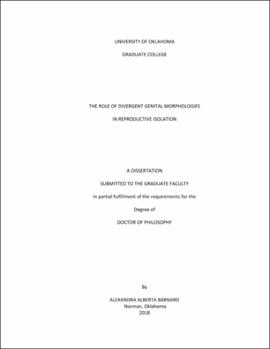| dc.description.abstract | How a single ancestral species can give rise to new, separate species remains a major outstanding question in evolutionary biology. Understanding speciation requires identifying how reproductive isolation (RI) is initiated and maintained in the early stages of population divergence. External male reproductive structures have received considerable attention as an early-acting cause of RI, because the morphology of these structures often evolves rapidly between populations. My dissertation research used a pair of recently diverged damselfly species in the genus Enallagma (Odonata: Coenagrionidae) to understand the role of divergent genital morphologies in causing RI at early stages of the speciation process. Specifically, I investigated the mechanisms by which species-specific morphologies limit gene flow between species, and then explored the relationships between morphological differentiation and overall genomic differentiation between species. My research focused on Enallagma anna and E. carunculatum, two damselfly species that diverged within the past ~250,000 years and differ conspicuously in their reproductive structure morphology, yet currently hybridize in at least one sympatric region. In chapter 1, I tested the importance of mechanical and tactile incompatibilities in RI between E. anna and E. carunculatum by quantifying 19 potential prezygotic and postzygotic RI barriers, using both naturally occurring and lab-reared damselflies. I found that mechanical incompatibilities between heterospecific male and female reproductive structures limit but do not completely prevent heterospecific mating attempts. However, females were significantly less likely to mate with hybrid or heterospecific males compared to conspecific males, which suggests that tactile incompatibility between male and female morphologies forms an additional mechanism to limits gene flow between these species. Postmating RI barriers appeared weak or nonexistent, which indicates that premating isolation, mediated by divergence in genital morphologies, was the first type of reproductive barrier to evolve in this group. These results highlight the potential for rapidly evolving genitalia to cause RI via tactile mechanisms, which may be a more widespread RI mechanism than we are currently aware of. In chapter 2, I more closely examined the female structures presumed to be important in evaluating male tactile signals during premating contact and influencing Enallagma female mating decisions. I quantified and compared several mechanosensory sensilla phenotypes on the female thorax among multiple sympatric and allopatric populations to test for evidence of reproductive character displacement, which would indicate that sensilla phenotypes are important in species recognition. My results suggest that species-specific placement of female mechanoreceptors is sufficient for species recognition, but mechanosensor variation among females within species may be important for mate choice within species. This hypothesis requires additional study to test the relationships between female sensilla phenotypes and behavior. This experiment reveals Enallagma’s potential as a study system for elucidating the neurobiological basis of female mating decisions. In chapter 3, I explored the relationships between morphological divergence and genomic differentiation during speciation. Persistent gene flow between species as they diverge can homogenize some regions of the genome and make differentiated regions stand out in comparison. Some of these highly divergent loci are predicted to harbor genes responsible for reproductive isolation. However, patterns of genome diversification at this stage remain poorly understood, such as how such loci are arranged across the genome and whether such loci commonly contribute to reproductive isolation or are simply less subject to recombination. I generated a set of genome-wide variant loci in a large collection of samples from multiple populations, including both natural and lab-reared hybrids. I used these loci to quantify introgression patterns in nature, identify divergent loci, and test for associations between genomic ancestry and species-specific phenotypic variation. The results suggest ongoing gene flow between E. anna and E. carunculatum in nature, but also demonstrate the challenge of differentiating shared ancestral polymorphism from recent admixture when studying young species. Additionally, the results revealed that estimated ancestry proportions in hybrids were a reliable predictor of hybrid reproductive structure phenotype in most cases – but some individuals appeared to have a genome that mostly resembled one parental species, yet morphology more similar to that of the other parental species. Clarifying the relationships between genotypes and phenotypes will likely require more fine-scale genomic sequencing efforts than this study obtained. My dissertation research integrated behavioral studies in the field and lab with quantitative trait comparisons and genomics to investigate the importance of rapid evolution of reproductive structures in reproductive isolation. This work enhances our understanding of how morphological divergence affects mating behavior to cause RI, and in turn how RI and behavior shape differentiation of genomes. Together, these experiments contribute to our understanding of how biodiversity is generated and strengthen the role of damselflies as models for understanding evolution. | en_US |
